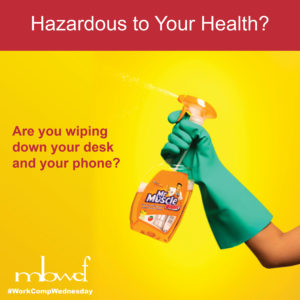What Chemicals Are You Using at Work?
Some cleaning chemicals can be hazardous, causing problems ranging from skin rashes and burns to coughing and asthma. You come into contact with chemicals every day. Although some chemical exposures are safe, others are not. For you to become sick, a certain amount of a harmful chemical must enter your body. Harmful chemicals can get into your body if you breathe, eat, or drink them or if they are absorbed through your skin.
Cleaners, sanitizers, and disinfectants serve different purposes, and it is important to choose the least hazardous cleaning chemical that will accomplish the task at hand. Before purchasing cleaning products, determine whether or not sanitizing or disinfecting is necessary. If sanitizing or disinfecting is not required, then choose a cleaner. In general, disinfectants and sanitizers are more hazardous than cleaners. If sanitizing or disinfecting is necessary, be sure that the product purchased is effective for the microorganisms being targeted. EPA regulates
sanitizers and disinfectants (termed “antimicrobial pesticides”). For further information, see EPA’s webpage “What Are Antimicrobial Pesticides?” (www.epa.gov/pesticide-registration/what-are-antimicrobial-pesticides).
The following are important issues to be discussed with workers:
• Make sure the room you are cleaning is well ventilated with a fan or an open window;
• Store your cleaning products in a safe place where your children cannot reach them;
• Keep cleaning products in their original containers;
• Do not mix cleaning products with one another;
• Follow the directions on the containers; and
• Clearly mark hazardous cleaners.
Employers must provide training to workers at a level and in a language and vocabulary that they can understand.
Let’s work together to keep everyone safe! Not currently an MBWCF member – click here to learn more about how to join!

